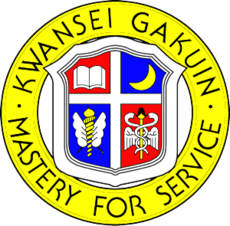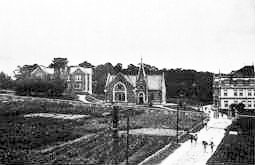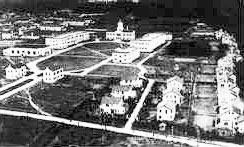Kwansei Gakuin University facts for kids
|
関西学院大学
|
|
 |
|
| Motto | 奉仕のための練達 (Hōshi no Tame no Rentatsu) |
|---|---|
|
Motto in English
|
Mastery for Service |
| Type | Private |
| Established | September 28, 1889 |
|
Religious affiliation
|
United Church of Christ in Japan |
|
Academic affiliations
|
ACUCA |
| Endowment | ¥196.9 billion (2022) (1.33 billion USD) |
| Chancellor | Motoo Nakamichi |
| President | Yasutoshi Mori |
| Chair of the Board of Trustees | Ippei Murakami |
|
Academic staff
|
786 (2023) |
|
Administrative staff
|
523 (2023) |
| Students | 25,679 (2023) |
| Undergraduates | 24,314 (2023) |
| Postgraduates | 1,365 (2023) |
|
Other students
|
1,040 International Students (2023) |
| Address |
1-155 Uegahara Ichiban-cho
,
,
,
662-8501
,
Japan
34°46′09″N 135°20′50″E / 34.7692°N 135.3472°E |
| Campus | Urban, 148 acres (60 ha) |
| Colors | Blue, White, and Yellow |
| Nickname | Fighters |
|
Sporting affiliations
|
Kansai Big Six |
| Mascot | Soraran |
 |
|
Kwansei Gakuin University (関西学院大学, Kansei Gakuin Daigaku), also known as Kangaku (関学), is a private university in Japan. It is a Christian school that welcomes all students. The university offers many different study programs, from Bachelor's to Doctoral degrees. About 25,000 students attend Kwansei Gakuin, studying nearly 40 subjects across 11 undergraduate and 14 graduate programs.
The main campus of Kwansei Gakuin is in Nishinomiya. The university also has other campuses in Kobe Sanda, Nishinomiya Seiwa, Nishinomiya Kitaguchi, Osaka Umeda, and Tokyo Marunouchi. Kwansei Gakuin University is part of the Japanese government's Top Global University Project. This means it is recognized as a university that helps students become global leaders. It is often considered one of the top four private universities in the wider Kansai region of Japan.
Contents
About Kwansei Gakuin
What's in the Name?
The name Kwansei Gakuin (関西学院, Kansei Gakuin) comes from the university's founder, Walter Russell Lambuth. He wanted to serve people in Kansai (関西), which is the western part of Japan. The word Gakuin (学院) means "college." The spelling "Kwansei" instead of "Kansai" is a bit old-fashioned. It shows how some students in the late 1800s would have pronounced it. While the school song uses the "Kwan" sound, most people today say "Kan." The university is often called Kangaku.
School Motto: Mastery for Service
Kwansei Gakuin's motto is "Mastery for Service." This means that students should become skilled and knowledgeable people. The goal is to help students use their talents to help others, their community, and the world. It's about becoming a well-rounded person who can make a positive difference.
School Symbol: The Crescent Moon
The symbol of Kwansei Gakuin is a crescent moon. This symbol shows that education is a journey of growth. It means that students are always learning and growing in knowledge and wisdom, like the moon growing to its full shape.
Working with the United Nations
Kwansei Gakuin University has special agreements with some United Nations organizations. In 2003, it became the first university in Asia to partner with the United Nations Information Technology Service (UNITeS) to send volunteers. In 2006, the university also teamed up with the United Nations High Commissioner for Refugees (UNHCR) in Japan. This partnership created a scholarship program for refugees in Japan. The first students in this program started in April 2007.
What Can You Study?
Undergraduate Programs
Kwansei Gakuin offers many different subjects for students getting their first university degree. Here are some of the main schools:
- School of Theology (started in 1952)
- School of Humanities (started in 1934)
- School of Sociology (started in 1960)
- School of Law and Politics (started in 1948)
- School of Economics (started in 1934)
- School of Business Administration (started in 1951)
- School of Science and Technology (moved to Kobe-Sanda Campus in 2001)
- School of Policy Studies (started in 1995, at Kobe-Sanda Campus)
- School of Human Welfare Studies (started in 2008)
- School of Education (started in 2009)
- School of International Studies (started in 2010)
Graduate Programs
For students who want to continue their studies after their first degree, Kwansei Gakuin has several graduate schools:
- Graduate School of Theology (started in 1952)
- Graduate School of Humanities (started in 1950)
- Graduate School of Sociology (started in 1961)
- Graduate School of Law and Politics (started in 1950)
- Graduate School of Economics (started in 1950)
- Graduate School of Business Administration (started in 1953)
- Graduate School of Science and Technology (started in 1965, at Kobe-Sanda Campus)
- Graduate School of Policy Studies (started in 2001, at Kobe-Sanda Campus)
- Graduate School of Language, Communication, and Culture (started in 2001)
- Graduate School of Human Welfare Studies (started in 2010)
- Graduate School of Education (started in 2009)
The university also has professional schools like the Law School and the Institute of Business and Accounting.
Studying Abroad
Kwansei Gakuin University has partnerships with over 140 universities in other countries. This means many students can go study abroad. Each year, more than 700 international students come to study at Kwansei Gakuin.
University Campuses
Nishinomiya Uegahara Campus
Since 1929, the main Uegahara campus has been in Nishinomiya, Hyōgo. This campus was designed in a "Spanish Mission" style by William Merrell Vories. He was an American missionary, architect, and educator. In 2017, the campus won an award for its beautiful design. Most of the university's main offices are located here.
Nishinomiya Seiwa Campus
The Nishinomiya Seiwa Campus opened in 2009. It is home to the School of Education and Seiwa Junior College. This campus is only a 10-minute walk from the Nishinomiya Uegahara Campus.
Kobe Sanda Campus
The Kobe Sanda Campus opened in 1995 and is located in Sanda, Hyōgo. It houses the School of Policy Studies and the School of Science and Technology. This campus has the same architectural style as the main Nishinomiya-Uegahara campus. It takes about an hour to 70 minutes to get there from Nishinomiya by shuttle bus.
Osaka Umeda Campus
The Osaka Umeda Campus opened in 2004. It is a short walk from the main train stations in Osaka City. This campus offers graduate classes for people who are working. It also helps students find jobs and supports lifelong learning.
Tokyo Marunouchi Campus
The Tokyo Marunouchi Campus opened in 2007. It is on the 10th floor of the Sapia Tower, right next to Tokyo Station. This campus shares information and offers lectures. It also helps former students find jobs in the Tokyo area.
Sports at Kwansei Gakuin
Kwansei Gakuin has a wide variety of sports teams, with 34 different varsity teams. These teams compete in college leagues in the region. Even though the school does not offer special scholarships for athletes, its teams are very competitive. They often play against the best college teams in Japan in sports like American football, basketball, lacrosse, and soccer.
The Kwansei Gakuin Fighters are one of Japan's most successful American football teams at the university level. They have won a record 34 national championships!
Famous People from Kwansei Gakuin






